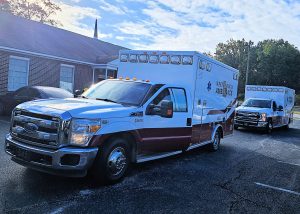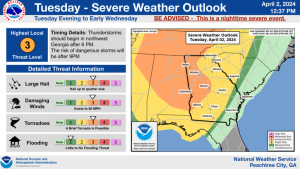The Coweta Judicial Circuit’s Office of the District Attorney said Tuesday they will not prosecute a man accused in the April 23, 2021 shooting death of a 33-year old Temple man. According to documents shared with WLBB Radio, the DA’s office believes there is not sufficient evidence to challenge the defendant’s claim of self-defense.
The state shared their final analysis of the case with the family of the deceased on Tuesday. The information is provided below in italics.
On April 23, 2021, at approximately 12:12 am, the Villa Rica Police Department responded to a shooting in the parking lot of a local bar in Villa Rica called The Watering Hole, located at 123 Tri County Plaza. There they discovered 33-year-old Joshua Ryan Dempsey lying in the parking lot suffering from a gunshot wound to his chest. Officers and paramedics rendered aid, but Dempsey soon succumbed to his injuries and passed away. Within minutes of officers arriving on scene, the shooter, 25-year-old Brannon Kemp Shirley, called 911 and drove himself to the Villa Rica Police Department to give a statement. During this interview, Shirley claimed that he acted in self-defense. Villa Rica Police Department then began their investigation.
Detectives learned that several weeks prior to the shooting, Dempsey began a romantic relationship with Shirley’s former girlfriend (KR). Perhaps in response, Shirley then began a romantic relationship with Dempsey’s former girlfriend, (BM). Shirley’s actions angered Dempsey, and this anger is reflected in text messages and social media messages recovered by Detectives. Those messages offer insight into the relationship between these individuals in the weeks preceding the shooting.
On multiple occasions prior to the shooting, Dempsey sent hostile communications to both (BM) and Shirley. On one occasion, Dempsey suggested that he would “ruin her life,” in reference to (BM). On the day prior to the homicide, Dempsey sent a message to others regarding Shirley, saying, “I’m going to hurt that little boy.” On at least two occasions, one earlier in April and the second on the day before the shooting, Dempsey attempted to goad Shirley into a physical altercation. Shirley declined to fight Dempsey, and he warned Dempsey that he would shoot Dempsey if Dempsey tried to fight him. Dempsey was much larger than Shirley, outweighing him by 45 pounds and standing 5 inches taller.
On the night of the shooting, (BM) decided to go to a bar called The Watering Hole in Villa Rica for drinks. Shirley desired to pick (BM) up from the bar later that evening. Shirley drove himself to the bar in his 2017 Chevrolet Silverado. According to multiple people, Shirley did not drink alcohol, and he was not interested in going inside the bar. Instead, he remained in his vehicle in the parking lot and waited for (BM).
As he waited in his truck in the parking lot, Dempsey and (KR) happened to arrive. Dempsey noticed Shirley in the parking lot and told (KR) that he was going to go speak with Shirley. A verbal altercation then ensued between the two men. During this altercation, Shirley remained in his vehicle as the two men insulted each other. The altercation soon ended, and Dempsey entered the bar with (KR). Shirley texted (BM), “they’re starting drama,” and then drove from the parking lot without (BM).
After leaving the parking lot, Shirley texted another woman named (SS), who was his former girlfriend prior to (KR), and who also was present at The Watering Hole. Although Shirley had left The Watering Hole parking lot, he returned after he and (SS) agreed via text to meet up. Their communications suggest the nature of their relationship at this time may have been romantic, which speaks to Shirley’s motive in returning to the incident location. Once Shirley arrived, he parked next to Dempsey’s 2008 Chevrolet Silverado, and (SS) entered Shirley’s vehicle.
According to the video surveillance inside the bar, within five minutes of (SS) exiting the bar to meet Shirley, Dempsey and (KR) closed their tab and exited the bar. At this time, Shirley and (SS) were still in Shirley’s vehicle in the parking lot. According to witness statements, as Dempsey approached his own vehicle, he and Shirley again began to argue. During this second altercation, Shirley remained in his vehicle and insulted Dempsey through his open driver’s side window. Within a minute, Dempsey reached into Shirley’s truck and slapped or punched Shirley in the face. Shirley remained in his vehicle and the two men continued to insult each other.
According to one witness, Dempsey dared Shirley to pull out his gun during the altercation, apparently referencing Shirley’s prior threats to shoot Dempsey in self-defense. Shirley did not pull out his weapon, but instead he continued to insult Dempsey. For a second time, Dempsey struck Shirley through the driver’s side window. Shirley remained in the truck. As Dempsey walked away, Shirley once again insulted Dempsey.
Dempsey then ran toward Shirley’s truck and within seconds jumped on the running board, apparently with the intention of again assaulting Shirley. As Dempsey did so, Shirley fired one shot from a 9mm pistol, striking Dempsey in the chest. Video evidence, along with the trajectory of the wound path and the ballistic evidence, is consistent with the shot being fired as Dempsey stood on the running board of Shirley’s truck during the attempted assault.
Investigators found a nearby business with a surveillance camera that covered the parking where the shooting occurred. Investigators obtained the footage of this third interaction between Dempsey and Shirley, wherein Shirley shot Dempsey, and included it in the investigatory file. While the surveillance camera presumably captured the other interactions in the parking lot that night, investigators only obtained the portion of the video footage that included the shooting.
LEGAL ANALYSIS
The sole question for the District Attorney’s Office in this case is whether Shirley was legally justified in shooting Dempsey under these circumstances. This analysis does not answer the moral question of whether Shirley should have shot Dempsey. It instead analyzes the legal question of whether the State could prove beyond a reasonable doubt that Shirley was not legally justified in using deadly force. In short, the District Attorney’s Office has concluded that it could not prove beyond a reasonable doubt that Shirley was not justified in shooting Dempsey.
Under Georgia law, Shirley is entitled to the protections of the commonly understood Defense of Self or Others, found in O.C.G.A. 16-3-21. However, the facts of this case make the more relevant legal defense the Use of Force in Defense of Habitation, found in O.C.G.A. 16-3-23. This is because a vehicle is defined as a habitation under Georgia law, and Shirley remained in his vehicle during the altercation. As discussed below, the State does not have sufficient evidence to overcome the Defense of Habitation.
DEFENSE OF HABITATION
Georgia law gives the same protections to citizens inside their vehicles as it does to citizens inside their homes. A “habitation” is defined by O.C.G.A. 16-3-24.1 as “any dwelling, motor vehicle, or place of business.” The protections afforded to those defending a habitation are more extensive than the protections afforded to citizens acting in defense of themselves or others. Essentially, Shirley is given the same protections under the law in his vehicle as if he were standing in the doorway of his own home during this altercation.
O.C.G.A. 16-3-23 reads as follows:
A person is justified in threatening or using force against another when and to the extent that he reasonably believes that such threat or force is necessary to prevent or terminate such other’s unlawful entry into or attack upon a habitation;
however, such person is justified in the use of force which is intended or likely to cause death or great bodily harm only if:
(1) The entry is made or attempted in a violent and tumultuous manner and he or she reasonably believes that the entry is attempted or made for the purpose of assaulting or offering personal violence to any person dwelling or being therein and that such force is necessary to prevent the assault or offer of personal violence;
(2) That force is used against another person who is not a member of the family or household and who unlawfully and forcibly enters or has unlawfully and forcibly entered the residence and the person using such force knew or had reason to believe that an unlawful and forcible entry occurred; or
(3) The person using such force reasonably believes that the entry is made or attempted for the purpose of committing a felony therein and that such force is necessary to prevent the commission of the felony.
Any of these three paragraphs can substantiate a claim for Defense of Habitation, and the State would be required to disprove that affirmative defense beyond a reasonable doubt. The first paragraph most closely tracks the circumstances present in this case.
Under Paragraph (1) of this code section, Shirley could use deadly force to prevent or to terminate an entry into his vehicle, if the entry was “made in a violent and tumultuous manner” AND the entry was made “with the intention of assaulting or offering personal violence to anyone inside the vehicle,” AND that such deadly force was necessary to prevent the assault or offer of personal violence.”
There is no dispute that the interaction between the two men can fairly be characterized as tumultuous, which is defined as “loud, excited and emotional.” It can also be fairly characterized as violent, as violence is defined as “the use of physical force so as to injure.” It does not matter how the injury was attempted, only that it was attempted. A punch or a slap may satisfy the element of physical force. Therefore, condition one of paragraph one is satisfied.
The fact that Dempsey had twice entered Shirley’s truck to slap Shirley makes it apparent that Dempsey was in fact attempting to enter Shirley’s truck to assault him when Shirley shot him. Breaking the plane of the driver’s side window with his hand and arm is sufficient to prove “entry” under Georgia law. The prior assaults and the context of the meeting, as generally described above, show Dempsey was acting with the intention of assaulting or offering personal violence to Shirley, who was still inside the vehicle. There is no requirement that Shirley actually be injured or even that he be in fear. All that is required is that that Dempsey “offered personal violence” to Shirley. Therefore, condition two of paragraph one is satisfied.
The most difficult question in this case as to a claim of Defense of Habitation is whether the violence offered by Shirley was necessary to prevent the assault by Dempsey. As an initial matter, according to Georgia law, Shirley had no duty to retreat by driving away, despite having the clear ability to do so. O.C.G.A. § 16-3-2 states that a person claiming justification “has no duty to retreat and has the right to stand his or her ground and use
force as provided in said Code sections, including deadly force.” Therefore, the fact that Shirley had the ability and opportunity to drive away prior to shooting Dempsey plays no role in this analysis.
To answer the question of whether the use of deadly force was necessary in this specific situation, Georgia law applies an objective standard, which asks whether a person faced with the same circumstances would reasonably believe that the use of force was necessary. In order to prevail at trial, the State has the burden of disproving this claim, and proving that a reasonable person would not have believed the shooting was necessary under the same circumstances.
Dempsey was the initial aggressor
As noted above, the text messages and social media records demonstrate that Dempsey was the aggressor and intended to initiate an assault against Shirley. In contrast, Shirley never suggested to anyone that he possessed a desire to assault Dempsey. While Shirley warned that he would shoot Dempsey, he conditioned it on Dempsey first assaulting him. Dempsey assaulted Shirley despite this warning of deadly force, and according to one witness, actually goaded Shirley into using the weapon. These facts are consequential to the analysis of whether Shirley’s use of force was necessary, as defined by Georgia law, because these facts are relevant to whether Dempsey’s assault would have been prevented or terminated if Shirley used less than deadly force.
The text messages also provide insight into Shirley’s reason for returning to the bar. Any evidence that Shirley returned with an intention of fighting or provoking Dempsey could be helpful in a prosecution of Shirley. However, the text messages rebut this theory, as they indicate that Shirley simply returned to meet with (SS). There is no evidence suggesting that Shirley returned to the parking lot seeking an interaction with Dempsey. Further, there is no evidence that Shirley had reason to believe that Dempsey would leave the bar after only having one drink. It therefore appears that Shirley’s second encounter with Dempsey was coincidental, and Shirley was not the initial aggressor.
Physical state of the two men
Analyzing whether the use of deadly force was necessary also requires considering the relative size of the two men. If Shirley was much larger and stronger than Dempsey, it could be argued that Shirley did not have to shoot Dempsey in order to prevent or terminate the assault. As noted earlier however, Dempsey was 5 inches taller and 45 pounds heavier than Shirley. Further, at trial, the evidence would show Shirley has a condition known as pectus excavatum, which is a condition in which a person’s breastbone is sunken into their chest. At 17, Shirley’s condition was addressed surgically by resetting his ribs and sternum, but the surgery resulted in a weaker chest relative to someone without the condition. This was in part why Shirley described himself to others as “not a fighter” and how the State expects Shirley’s defense would rationalize his warning of deadly force if faced with a physical assault from Dempsey.
Verbal provocations by Shirley during the fatal encounter
There is no dispute that Shirley was himself insulting and provoking Dempsey in the minutes prior to the shooting. Under some circumstances, that fact could be used by the State to disprove a claim of justification. For instance, O.C.G.A. § 16-3-21(b)(1) provides that a citizen is not justified in using force against another if that person “initially provokes the use of force against himself with the intent to use such force as an excuse to inflict bodily harm upon the assailant.” However, this limitation only applies to Defense of Self or Others, and statutorily it does not apply to Defense of Habitation. As such, even if the State could prove that Shirley wanted to shoot Dempsey, and that he provoked Dempsey hoping to use deadly force in retaliation, it would not factor into the analysis for Defense of Habitation.
CONCLUSION
In a criminal prosecution, the defendant does not have to prove that he acted in defense of self, others, or habitation. He merely needs to assert one or all of these affirmative defenses and the State must then disprove the claim beyond a reasonable doubt. The facts analyzed above weigh heavily against the State’s ability to meet its burden of proof against Shirley. After reviewing the witness statements, the surveillance video, the social media records, the 911 calls, the photographs, the body camera footage, the autopsy of Dempsey, and all of the other documentation and reports relevant to his case, this Office has concluded that there is insufficient evidence to rebut a claim of Defense of Habitation by Shirley. Consequently, the District Attorney’s Office declines to pursue the prosecution of Shirley and considers this matter closed.


















